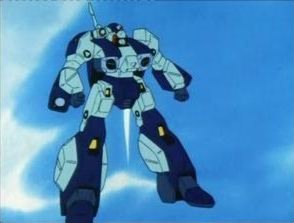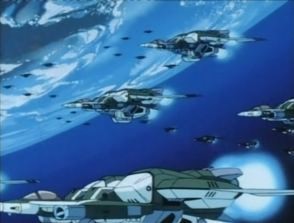|
The
1980s were changing times for American kids' TV audiences.
A growing culture of commercialisation was slowly seeping
through; animation series were starting to be produced to
sell toys to children, like half-hour advertisements. Everyone
knows He-Man, the best-known example of this phenomenon,
which in turn led to the massive fads of Teenage Mutant
Ninja Turtles and Power Rangers. But not many
casual children's TV watchers would know that certain seemingly-American
series were in fact imported Japanese animé shows, heavily
edited and re-dubbed so as to appeal to American audiences.
Animé
had been growing in popularity with Western audiences for
some years. Devoted fans, frustrated over the lack of American-released
videotapes of the most popular animé series, resorted to
bootlegging imported Japanese copies, applying their own
subtitles, and distributing them to other fans around the
country. No mean feat, considering that this was well before
the advent of the Internet and its easy methods of communication.
The level of organisation of these fans was impressive;
they had mainly branched out from American comic-books like Fantastic Four and Spider-Man, so the fans'
connections were largely already there – just being put
to a different use.

American
translation and syndication of Japanese shows had begun
in the 1960s, with Osamu Tezuka's Mighty Atom,translated
as "Astro Boy"; Kimba the White Lion (which would
cause controversy in the 1990s with Disney being accused
of stealing the characters for The Lion King) and
Gigantor. Speed Racer followed later; the
dubbing work done by the American translators would be widely
lampooned, as all the characters appeared to be talking
very, very quickly! And to cash in on the huge Star Wars
craze of the late 1970s, Battle of the Planets (better
known as Gatchaman in Japan) appeared to wow American
audiences with its fast and furious space battles. All of
these shows were edited to remove violence and other "undesirable
content", something that annoyed die-hard animé fans to
no end. They wanted to see the shows as the Japanese did,
and resented the implication that these series were only
for kids.
Robotech,
released in 1985 and created from three seperate animé series
(Super Dimension Fortress Macross, Super Dimension
Cavalry Southern Cross and Genesis Climber Mospeada),
promised to make amends. Aside from excising extreme violence,
gore and sexual suggestiveness, it was largely unaltered
from the source material – it depicted violent space conflict
and wars in a way that had yet to be seen by American animation
audiences, and retained a great deal of its complex characterisation.
Upon a popular character's death, series producer Carl Macek
was asked by fans "How long will it be before you bring
him back?". Bemused, Macek answered "He's dead! He was fatally
shot! That's what war is about, he's not going to come back!"*
Robotech
is frequently credited as the series that inspired the mainstream
interest in animé for the Western world. Because the three
source series were not in any way related to oneanother,
Harmony Gold (the production house responsible for Robotech)
established continuity by naming the events of each series
as a self-contained "Robotech War," stemming from the discovery
of 'protoculture', a miracle energy source. Thus, each saga
has different characters and themes.
Robotech:
The New Generation is the adaptation of Genesis Climber
Mospeada, the third and final chapter in the original
Robotech series. After destroying the malevolent Robotech
Masters at the end of the second saga, Earth's defence force
is severely weakened, and cannot put up any resistance when
the marauding alien Invid attack. These Invid seek to obtain
Earth's large supply of protoculture, and quickly take over
the entire planet. All that's left are a few scattered resistance
cells, and the hope that the Robotech Expeditionary Force
will return from Mars to help them.

We
join the conflict just as the REF arrive to fight off the
Invid. However, the gathered forces are no match for the
sheer number of Invid defending the planet, and the entire
force is destroyed – leaving only one survivor, Scott Bernard,
a wing commander in the REF. Scott was due to marry his
girlfriend and fellow REF officer, Marlene, but since she
died in the initial Invid offensive, all he has of her is
a holographic locket. There's no shortage of people willing
to tag along with him while he's roaming the planet, searching
for the Invid's main hive, Reflex Point: first, there's
Rand, a traveling scavenger; Annie, a lovesick (and annoying)
young girl; Lunk, an out-of-work engineer; Lancer, a cross-dressing
lounge singer; and Rook, a fiery and strong-willed young
woman who is almost Scott's equal in mecha combat.
Volume
1, to be released 31st July by Manga, is a double-disc edition
featuring twelve of the twenty-five episodes in this series.
New Generation is very easy to get into – you don't
need to have watched either of the two Robotech series before
it, as it has different characters and settings, and only
vaguely references events in the previous series. The wonderfully
comprehensive narrator, who explains the story so far at
the beginning of each episode and provides a running commentary
through "traveling across the country" scenes, is a welcome
benefit. All too often, modern animé series expect the viewer
to pick the story up as they go along, offering little or
no explanation as to why its events are taking place. Apparently,
it was all much simpler back in the days of Robotech...
It
would be very unfair to compare Robotech's
animation with that of the modern series I've become used
to reviewing, but I must make a few notes – even though
you'd expect the older style to be jarring, it simply isn't.
You don't even have to get used to it; as long as you accept
that this was made in the mid-1980s, and that it's meant
to look like this, it's really no different from any of
the modern animé series. In fact, I'd say that Robotech's
animation is very good for the time it was made. The mecha
combat scenes look great; most of Robotech's
fighting is done via "Cyclone" motorcycles that can become
large suits of robot armour, a la Transformers, and
jet fighters with similar capabilities. Explosions are rendered
rather artistically; I noticed a lot of detail.
Music,
unfortunately, doesn't fare as well. While I'm sure that
the synthesised electronic themes and incidental music was
all the rage back in the 80s, from a 21st-century perspective,
it now sounds...well, "cheesy" is the only word I can think
of to describe it. The slightly better main themes and the
vocal song in episode 63, "Lonely Soldier Boy," manage to
save it just slightly. The dub, while performed well (and
by several well-known industry names, albeit using pseudonyms
to avoid union problems), suffers from a script that contains
far too many clichéd battle taglines and other badly-articulated
translations.

I'm
enjoying Robotech: The New Generation so
far. It belongs to what could almost be considered a bygone
age of animé – the era of highly-Americanised and edited
animé, produced for a syndicated Saturday-morning audience.
It reminds me of my youth, growing up and watching shows
like Teenage Mutant Ninja Turtles and ThunderCats
on long holiday mornings, but with as much plot and character
development as you'd expect from a more modern animé. For
sheer nostalgic escapism, it can't be beaten.
Framed
4:3, the image quality is good but not great, being slightly
soft and displaying some very visible compression artefacts
in places. Some of this is no doubt down to the transfer
from NTSC to PAL, although the step-frame animation style
avoids obvious motion blurring. Colours are strong enough,
but the age of the series is evident in the transfer.
There's
only one sound option here, (American) English 5.1. The
dialogue and voice-overs are a little on the tinny side,
with even the music having rather crisp trebles, but otherwise
music and sound effects are rather well mixed, with very
good seperation at times and strong bass reproduction.
No
special features are present; Manga seem to have sacrificed
them in order to squeeze six episodes on each disc. Strangely
enough, I think prefer it like this – too many times, animé
disc special features have been lackluster and almost not
worth including, and I'd much rather have more episodes
in each volume. Not only do you get more for your money,
you save money (and shelf space!) overall.
As
this is the edited Robotech series, which
was adapted from three different animé shows, there's no
Japanese language track or subtitling present. It's like
comparing Super Sentai to Power Rangers –
the same material, but you wouldn't expect Japanese dubs
on Power Rangers just because its source
footage is Japanese.
*
As related to Fred Patten, Amazing Heroes #75, July
1985.
|